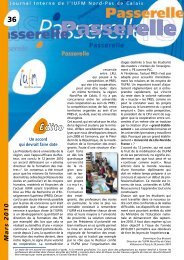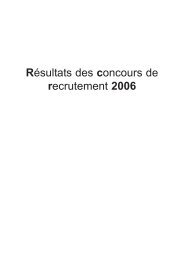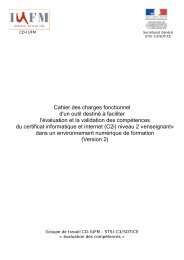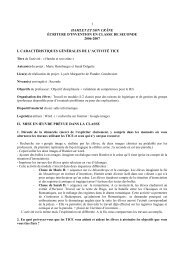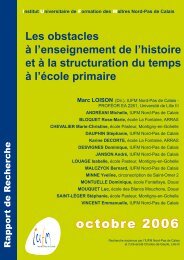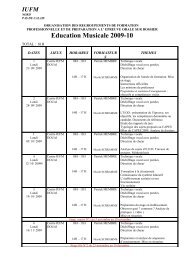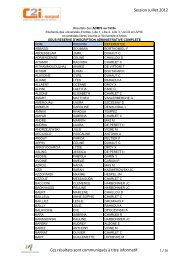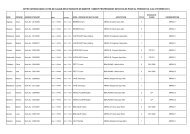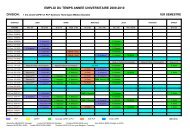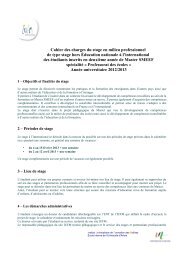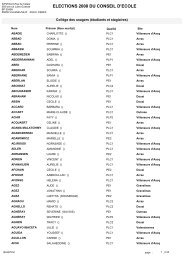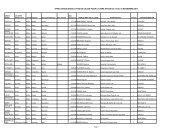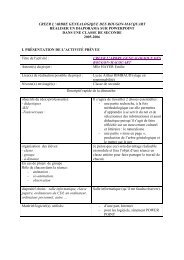You also want an ePaper? Increase the reach of your titles
YUMPU automatically turns print PDFs into web optimized ePapers that Google loves.
2.2.3. Univocal implicative links : the case of some linguistic characteristics.<br />
The comp<strong>le</strong>xity of some of the graphs studied above shouldn’t mask the fact that in some<br />
cases they are in fact extremely simp<strong>le</strong>. Their “simplicity” is nonethe<strong>le</strong>ss a source of<br />
information that shouldn’t be overlooked. Here we will focus on the study of links between<br />
the items corresponding to the linguistic characteristics of the texts produced by pupils.<br />
These characteristics have to do with the <strong>le</strong>ngth of text produced, the different modes used<br />
(infinitive, imperative, indicative), subjects (“I”, “we”, “you”). We have also kept the signs<br />
of planning : as a matter of fact the task that is proposed can be interpreted as one of the<br />
writing of a series of actions aiming at putting the figure back together. Some pupils write<br />
in an orderly list of actions. Others note the temporality by using adverbs (now, then etc.).<br />
Others conclude their texts by an indication of the type “here it is, the figure is done” or<br />
simply by using the word “end”. Some disorders can come from planning operations. Thus,<br />
some pupils refer to e<strong>le</strong>ments that have not yet been introduced in their text ; others add<br />
constraints that “they had forgotten”.<br />
Lastly, one of last characteristic of the produced writings is that of the inadequate use of definite<br />
artic<strong>le</strong>s – “the…” and indefinite – “a, some…” As a matter of fact, the presented e<strong>le</strong>ments<br />
can be undetermined by what is preceding them or on the contrary entirely determined. For<br />
instance, if the pupil has said how to build the four points ABCD on two perpendicular lines<br />
which intersection is 0, the circ<strong>le</strong> he is then going to talk about (0 being its centre and going<br />
through the 4 points) is entirely determined. Thus these determinations are not of a linguistic<br />
order : it isn’t because one e<strong>le</strong>ment has already been quoted in the text that it is thereof<br />
determined, but because the geometrical constraints define it in a unique way. There is no<br />
doubt then, that the tension between the two orders of determination explains the numbers<br />
of disorders in the use of artic<strong>le</strong>s.<br />
If there are quite many linguistic characteristics, on the other hand, the graph isn’t really<br />
comp<strong>le</strong>x. Three main ru<strong>le</strong>s stand out ; the two last ones are univocal.<br />
–<br />
–<br />
–<br />
(1) “Writing “I” implies “using the indicative mode”(99%).<br />
(2) “Using the infinitive mode” implies “Building a generic subject “we” “(99%)<br />
(3) “Using the imperative mode” implies “building a subject “you””(99%)<br />
The links that come up are expected for the most part since the very use, even partial of the<br />
imperative and infinitive modes are indeed linked to the pronouns which signal what the reader<br />
puts back together : a “peer” for the imperative mode, signal<strong>le</strong>d by the pronoun “tu” (informal<br />
you) and “vous” (formal you), “a generic reader” for the infinitive mode, an “evaluative reader”<br />
signal<strong>le</strong>d by “I” and the indicative mode. However, the presence of univocal relationships<br />
between the chosen pronouns and the modes used, gives an unexpected rigidity since it is<br />
possib<strong>le</strong>, in the indicative mode to use “on (peop<strong>le</strong>)” and “tu (informal you)”. Unlike classical<br />
tests suggesting symmetrical links between studied variab<strong>le</strong>s, the S.I.A. allows questioning<br />
on these strong constraints, stemming from the written production’s school situation.<br />
This makes it possib<strong>le</strong> to think that the ru<strong>le</strong>s pupils use define them as actualisations of<br />
discursive genres. Thus, we suppose that building the reader as a “peer” is characteristic of<br />
a school writing genre in maths class, and therefore can be perceived as <strong>le</strong>gitimate by pupils<br />
for several reasons. It can be that the pedagogical and didactical devices make such positions<br />
possib<strong>le</strong> because help and cooperation are princip<strong>le</strong>s put into practice in the language used<br />
in the different subjects taught. It could also be that the ways exercises are written in school<br />
books define such a reader. Building a “generic reader” is also an identifiab<strong>le</strong> characteristic.<br />
114<br />
<strong>IUFM</strong> Nord-Pas de Calais




